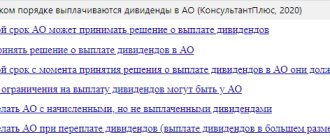Where to begin
So, the results have been calculated, taxes have been paid, and net profit has been determined.
And everything seemed to work out so beautifully, the period was closed with the treasured credit balance on the 84th account. But there is no need to rush into making a decision on paying dividends. First you need to analyze a number of indicators that allow the payment of such income. For example, if a company has recently been created and profits are being distributed for the first time, you need to check whether the authorized capital is fully paid up. If there are participants who have not contributed their share, payment of dividends is impossible. Next, you need to calculate the value of net assets, the procedure for determining which was approved by Order of the Ministry of Finance of Russia dated August 28, 2014 No. 84n. If this indicator turns out to be less than the cost of the authorized capital, the profit is not distributed. It is also worth paying attention to the fact that the value of net assets should not be lower than the authorized capital even after payment of dividends.
In practice, there are situations when a profit is generated at the end of the reporting period, but in fact there are no funds to pay dividends. There are many reasons for this situation, and most of them lie in the accounting methodology itself. Therefore, you need to make sure that the organization’s current account has or will soon have money to pay income to participants.
note
From January 1, 2015, the personal income tax and income tax rate on dividends received by residents of the Russian Federation was increased to 13 percent. Let us remember that last year dividends were taxed at a rate of nine percent.
Reasons for payment
The main basis for calculating dividends for a particular period in an LLC is the decision recorded in the minutes of the meeting of the company’s founders.
Also, a mandatory requirement for making a decision is the maintenance of accounting records, which clearly record the amount of retained earnings from previous periods or current income.
In joint stock companies, the recommendation on the amount of accruals is made by the authorized board of directors, after which the final decision is made at the general meeting of shareholders.
The essential fact established in the minutes of the meeting must include:
- accrual period;
- the amount of distributed profit;
- payment form.
In what cases should dividends not be paid?
There are certain legal restrictions that prohibit paying dividends from the company’s retained earnings when the organization:
- The amount of net assets (NAV) is less than the sum of equity capital and reserve fund or will become less during the course of payment.
- The debt of the participants in forming the authorized capital of the company has not been fully repaid.
- At the time of the decision, the organization showed signs of bankruptcy.
When can dividends be paid?
In accordance with the law, a limited liability company can distribute profits quarterly, every six months or every year (Clause 1, Article 28, Law No. 14-FZ dated 02/08/1998). The maximum payment period is 60 days from the date of the decision. Participants can independently determine the payment period by specifying it in the company’s charter or in the decision on the distribution of profits. If information about the timing is not documented, then dividends must be paid within 60 days.
But what to do if the deadline for dividend payments has passed, and the participants still have not seen their money? In this case, the founders have the right, within three years after the end of the payment period, to contact the company with a demand to receive their share of the income. By the way, the period can be extended to five years if this is specified in the company’s charter.
Amount and form of dividend payments
Profit is distributed among the participants in proportion to their shares contributed to the authorized capital. In other words, if a participant's share is 25 percent, then he will receive income within his 25 percent of the distributed profit. However, the charter may prescribe a different procedure for paying dividends, regardless of the size of the participant’s share. This procedure must be prescribed in the constituent document at the stage of creation of the organization or through amendments.
Currently, the list of participants and their shares is not required to be reflected in the charter. Therefore, it is enough to state here that profits are distributed disproportionately to shares in the authorized capital. Data about the participants and the ratio in which they will receive income can be fixed in the agreement on establishment or directly in the decision on the distribution of profits.
Important
If interim dividends were paid in 2014, and personal income tax was withheld and transferred from them at a rate of nine percent, then there is no need to recalculate the tax at the increased rate. The new tax rate (13 percent) applies to payments made directly in 2015.
Participants can receive their income both in cash and in kind. The law does not oblige the founders to prescribe in the charter the method of paying dividends. Therefore, the form of payment of participants’ income can be specified in the decision.
How to calculate dividends
The amount of dividends for each company participant is determined based on the amount of net profit received by the organization in proportion to the shares of the company participants in the authorized capital of the organization.
Net profit is the part of an organization’s profit that remains at its disposal after paying taxes, fees, deductions and other obligatory payments to the budget. It is a calculated value and is determined on the basis of balance sheet data. Therefore, it is entirely dependent on the accounting valuation of the various asset and liability items of the balance sheet.
Net profit is reflected in account 99 “Profits and losses”. At the end of the reporting year, when preparing the annual financial statements, the final entry in December, the amount of net profit (loss) of the reporting year is written off from account 99 to the credit (debit) of account 84 “Retained earnings (uncovered loss)” and is reflected in section 3 of the liabilities of the annual balance sheet.
Thus, the logic is this: they determined the net profit, distributed dividends into shares, and paid them minus taxes.
Profit distribution decision
The decision on the distribution of profits is made by a majority vote at the general meeting of participants and is documented in minutes or by a decision of the sole participant.
The protocol (decision) must contain information such as:
- period profits are distributed;
- the amount of profit to be distributed;
- proportions of distributed profits;
- participants who are due payment of dividends, indicating the amount of such payment;
- timing of income payment;
- form of dividend payment.
Participants have the right to indicate other information in the document if, in their opinion, it can provide clarity and help avoid conflicting situations in the future.
After the dividend payment procedure has been carried out, it must be properly reflected in accounting and tax accounting.
Taxation of dividends has its own characteristics, which an accountant must remember. After all, for example, the composition of participants and the form of distributed profits determine what taxes society will ultimately have to pay. Let's look at this in more detail.
Participants – individuals
So, if the participants of the company are individuals, then payments in the form of dividends are subject to personal income tax at the following rates (Article 224 of the Tax Code of the Russian Federation):
- 13 percent when paying income to persons who are residents of the Russian Federation;
- 15 percent when paying income to persons who are not residents of the Russian Federation.
It should be noted that when calculating personal income tax at a rate of 13 percent, tax deductions do not apply to “dividend” income (Article 210 of the Tax Code of the Russian Federation). Therefore, the tax base for income in the form of dividends should be formed separately from other income.
Participants-legal entities
If there are legal entity participants in the organization, the company has an obligation to pay income tax at the following rates:
- zero percent on dividend payments received by Russian organizations. An organization can take advantage of the benefit if a number of conditions are met, namely: on the date of the decision to pay income, the company must own a 50 percent share (or more) in the authorized capital. The period of ownership of shares is at least 365 calendar days, and it must not be interrupted. Or the company owns depositary receipts that give it the right to receive dividends, the amount of which corresponds to at least 50 percent of the total amount of dividends paid;
- 13 percent on income received in the form of dividends from Russian and foreign organizations. This rate is used by Russian companies that do not have the right to use the 0 percent rate;
- 15 percent on income received in the form of dividends by foreign organizations from Russian companies.
All organizations must pay income tax on dividends, regardless of their tax system.
Example 1
Olympus LLC decided to distribute profits in the amount of 100,000 rubles. The organization consists of three members:
- Petrov P.P., resident of the Russian Federation, share in the authorized capital – 35 percent;
- Fedorov F.F., resident of the Russian Federation, share in the authorized capital - 20 percent;
- Meridian LLC, resident of the Russian Federation, share in the authorized capital – 45 percent.
The calculation of dividends of participants and taxes due to Olympus LLC is summarized in the table:
| Member of the organization | Share in authorized capital, % | Amount of accrued dividends (100 thousand rubles x group 2) | Personal income tax/income tax rate % | Amount of tax to be withheld (gr.3 x gr.4) | Amount of dividends to be paid (gr. 3 – gr. 4) |
| 1 | 2 | 3 | 4 | 5 | 6 |
| Petrov P.P. | 35 | 35 000 | 13 | 4550 | 30 450 |
| Fedorov F.F. | 20 | 20 000 | 13 | 2600 | 17 400 |
| Meridian LLC | 45 | 45 000 | 13 | 5850 | 39150 |
The situation discussed in this example is most typical for Russian realities, when the organization paying dividends did not itself receive dividends, and its members include participants who are residents of the Russian Federation.
If the company is also a recipient of dividends, then the withholding tax is calculated in accordance with paragraph 5 of Article 275 of the Tax Code:
N = K x CH x (D1 – D2)
,
where N is the amount of tax subject to withholding;
K – the ratio of the amount of dividends subject to distribution in favor of the taxpayer-recipient of dividends to the total amount of dividends subject to distribution by the Russian organization;
Сн – tax rate (13%);
D1 – the total amount of dividends to be distributed by the Russian organization in favor of all recipients;
D2 – the total amount of dividends received by a Russian organization in the current reporting (tax) period and previous reporting (tax) periods, provided that these dividend amounts were not previously taken into account when determining the tax base. When calculating this indicator, dividends received from organizations that apply a profit tax rate of zero percent are not taken into account.
Using this formula, personal income tax and income tax on dividends of Russian participants are calculated. If among the participants of the organization there are non-residents of the Russian Federation, then taxes are calculated in accordance with paragraph 6 of Article 275 of the Tax Code:
Tax = Amount of dividends paid x 15%
Example 2
Olympus LLC received dividends from Nimfa LLC on March 1, 2015 in the amount of 50,000 rubles. At the general meeting, the participants of the organization decided to distribute profits in the amount of 100,000 rubles. and payment of dividends in the following amounts:
- Fedorov F.F. - 35,000 rubles. (is a resident of the Russian Federation);
- Pitridi K. - 20,000 rubles. (not a resident of the Russian Federation);
- LLC "Meridian" - 45,000 rubles. (is a resident of the Russian Federation).
The company's net profit is distributed among participants in proportion to their shares in the authorized capital. There are no grounds for applying a zero rate for income tax.
First, let's calculate the amount of taxes that the organization will have to withhold from dividends of Russian resident participants:
The total amount of dividends paid in favor of Russian participants is 80,000 rubles. (35,000 + 45,000).
Personal income tax on dividends from Fedorov F.F.:
35,000 rub. : 80,000 rub. x 13% x (80,000 rub. – 50,000 rub.) = 1,706 rub.
The participant will receive dividends in the amount of RUB 33,294. (35,000 – 1706).
Income tax on dividends of Meridian LLC:
45,000 rub. : 80,000 rub. x 13% x (80,000 rub. – 50,000 rub.) = 2,194 rub.
An amount equal to RUB 42,806 will be credited to the company’s account. (45,000 – 2194)
Let's calculate the amount of tax that an organization must withhold from dividends of a non-resident participant of the Russian Federation.
Personal income tax on dividends Pitridi K.:
20,000 rub. x 15% = 3000 rub.
The participant will be paid dividends in the amount of 17,000 rubles. (20,000 - 3000).
Withheld taxes will need to be transferred to the budget within the following time frames:
- Personal income tax - no later than the day of payment of dividends to the participant (clause 6 of article 226 of the Tax Code of the Russian Federation).
- income tax - no later than the next day after the transfer of dividends to the participant (clause 4 of article 287 of the Tax Code of the Russian Federation).
We remind you that the company must report to the tax authorities on the amounts of taxes withheld.
When paying dividends to an organization, an income tax return is filled out, consisting of a title page, subsection 1.3, section. 1 and sheet 03. It must be submitted no later than the 28th day of the month following the reporting period in which the income was paid.
Dividends paid to individuals are reflected in certificate 2-NDFL, which must be submitted before April 1 of the year following the year of payment of income.
Payment of dividends in kind
If there is no cash, the organization can pay dividends with property (for example, goods, finished products, fixed assets). However, this method is not profitable because it entails the payment of taxes, such as VAT and income tax. At the same time, the organization’s obligation as a tax agent remains intact. Please note that property for payment of dividends must be transferred at prices not lower than market prices (to avoid underestimating the base for determining taxes). Personal income tax in this case is calculated based on the value of the property, including VAT. If the organization does not have the opportunity to withhold and transfer personal income tax from the transferred property, the participant and the Federal Tax Service Inspectorate with which the tax agent organization is registered must be notified about this within a month.
Dividends have not arrived in your brokerage account - what to do?
A percentage of the Central Bank's profit is credited to the broker's account as follows:
- Receipt of dividend payments to shareholders in the depository of the Investment Chamber.
- Transfer of funds to the investor's trading account.
Operations are performed on the day of transfer of dividends to the depositary. The information is displayed in the client's personal account.
All data comes with the broker’s report in the table “other deposits and debits of funds”. The column indicates the name of the company and the amount transferred to the trader’s account.
Reflection of dividend payments in accounting
For clarity, we will consider the reflection of payment of income to participants using an example.
Example 3
Olympus LLC decided to distribute profits and pay dividends to participants in the following amounts:
- Petrov P.P. — 35,000 rubles, incl. Personal income tax - 4,550 rubles (resident of the Russian Federation, not an employee of the company);
- Fedorov F.F. — 20,000 rubles, incl. Personal income tax - 2600 rubles (resident of the Russian Federation, is an employee of the company);
- LLC "Meridian" - 45,000 rubles, incl. Income tax - 5850 rubles (resident of the Russian Federation).
The accountant of Olympus LLC must make the following entries:
DEBIT 84 CREDIT 75
— 35,000 rub. – dividends were accrued to Petrov P.P.;
DEBIT 84 CREDIT 75
— 45,000 rub. – dividends accrued to Meridian LLC;
DEBIT 84 CREDIT 70
— 20,000 rub. – dividends were accrued to Fedorov F.F.;
DEBIT 75 CREDIT 68
— 4550 rub. – personal income tax was withheld from the income of Petrov P.P.;
DEBIT 75 CREDIT 68
<- 5850 rub. – income tax was withheld from the income of Meridian LLC.
DEBIT 70 CREDIT 68
— 2600 rub. – personal income tax was withheld from the income of Fedorov F.F.;
DEBIT 70 CREDIT 50 (51)
— 17,400 rub. – dividends were paid (transferred) to Fedorov F.F.;
DEBIT 75 CREDIT 50 (51)
— 30,450 rub. – dividends were paid (transferred) to Petrov P.P.;
DEBIT 75 CREDIT 51
— 39,150 rub. – dividends of Meridian LLC are listed;
DEBIT 68 CREDIT 51
— 7150 rub. – the withheld personal income tax is transferred to the budget;
DEBIT 68 CREDIT 51
— 5850 rub. – the withheld income tax is transferred to the budget.
Olga Fedun
, for the magazine “Practical Accounting”
Help your business grow
Invaluable experience in solving current problems, answers to complex questions, specially selected latest information in the press for accountants and managers. Choose from our catalog >>
If you have a question, ask it here >>
Accounting entries
The following table shows the accounting entries for dividend accruals from the organization’s undistributed private equity:
| DEBIT | CREDIT | Action |
| 84 | 75 | Formation of a dividend base for participants who are not employees of the company |
| 84 | 70 | Formation of a dividend base for participants who are employees of the company |
| 75 | 68 | Tax Withholding for Non-Employee Participants |
| 70 | 68 | Withholding tax from participants who are employees |
| 75 | 50,51 | Dividends are paid to non-employees |
| 70 | 50,51 | Dividend payments were made to employees |
| 68 | 51 | Personal income tax deduction |
| 75 | 84 | Transfer of unpaid dividend flows to persons who are not employees of the organization into the company's retained earnings |
| 70 | 84 | Transfer of unpaid dividend flows to persons who are employees of the organization into the retained earnings of the company |









